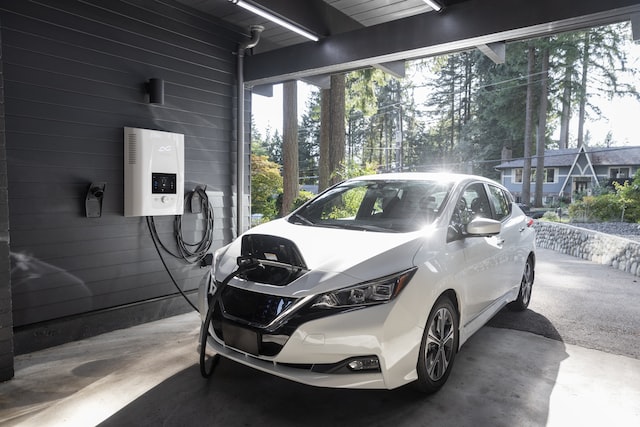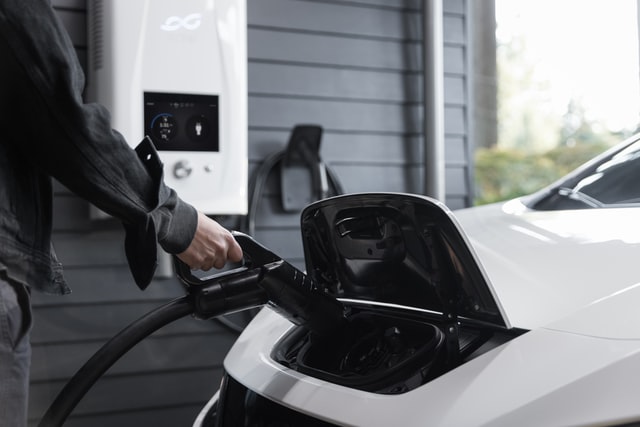The United States and European Union governments have released mandates for car manufacturers to make massive EV pushes in the coming years. EVs will become more affordable as technology advances and becomes more efficient, but those looking to go greener now don’t need to feel as if they have to wait to plug in.
Top Affordable EVs
Here are some of the best affordable EVs on the market today. This list is followed by a quick guide on charging your EV.
Chevrolet Bolt
Estimated Charging Times: 4 miles/hr at 120V. Full charge in approximately 7 hours at 240V.
DC Fast Charging Capability: Yes, with up to 100 miles per 30 minutes of charging.
Estimated range on full charge: Approximately 259 miles.
The Chevrolet Bolt EV is one of the most affordable electric vehicles on the market. The Bolt EV provides a lot of capability for its lower price, including an infotainment system featuring a 10.2-in-diagonal color touchscreen display, Android Auto, and wireless Apple CarPlay.
This EV also comes packed with safety features. Chevy Safety Assist comes standard, including a forward collision alert, automatic emergency braking, and following distance indicator.
Chevy has done a great job providing a safe and fun car for an affordable price. The 2022 model has been an EV fan favorite since it came out, and the buzz got louder when Chevy announced the 2023 model would be available at a reduced base MSRP of $26,595 – making it at the time of the announcement the most affordable EV coming to the market.
The Chevrolet Bolt EV is a small car, but the 2023 model boasts a max cargo room of 57 cubic ft when the rear seats are folded. So you’ll have plenty of room for your stuff if you’re traveling alone or with another person.
Nissan Leaf
Estimated Charging Times: The Leaf comes in two options, standard and S Plus. The standard Leaf reaches max charge using 240V in 8 hours, with the S Plus reaching max in 11.5 hours. Nissan doesn’t provide charging times when using a 140V cable, but you can use this method if necessary.
DC Fast Charging Capability: Yes, with an approximately 80% charge in 40-60 minutes.
Estimated range on full charge: Up to 149 miles with a standard Leaf, and 226 miles with the Leaf S Plus.
The Nissan Leaf provides a nice mix of touchscreen and physical buttons, combining new and old technology into a user-friendly experience.
Nissan put a lot of creature-comfort features into this EV. Available heated seats and steering wheel provide that extra bit of warmth needed on cold mornings. It also boasts automatic temperature control, which allows you to input your preferred settings, and the vehicle adjusts as needed to keep your ideal comfort level.
The Leaf places a premium on connectivity. In addition to Apple CarPlay and Android Auto integration, you can connect nearly any device to your EV through Bluetooth. USB-A and USB-C ports ensure you’ll have no issues connecting any device to your vehicle.
You can also fully customize your 8-inch infotainment screen to show a variety of options, from navigation to battery charge.
Mazda MX-30
Estimated Charging Times: Full charge in 13 hours and 40 minutes at 110V. Full charge in 2 hours and 50 minutes at 220V.
DC Fast Charging Capability: Yes. Charge from 20% to 80% in approximately 36 minutes.
Estimated range on full charge: Approximately 100 miles.
The Mazda MX-30 EV comes in two trims, the basic and Premium Plus. There are more bells and whistles in the Premium Plus, but both vehicles offer the most of the same core features that make this one of the more comfort-focused electric vehicles on the road.
EV owners already take pride in driving a vehicle that contributes to lowering emissions and the MX-30 takes being environmentally conscious a step further by using recycled threads, cork, and other sustainable materials. The blend of luxury, comfort, and sustainability makes this a popular choice for EV consumers.
Mazda included a variety of safety features in the MX-30 EV, with radar cruise control being one of the more unique. This feature automatically determines the speed of the vehicle in front of you and maintains a set speed and minimal distance behind that vehicle.
Most of the same smartphone integrations available with other EVs are available with the MX-30, but Mazda takes connectivity a step further with MyMazda. You can use this app to search for charging stations, check battery charge level and remaining range, and set up remote charging.
MINI Cooper SE
Estimated Charging Times: 2%/hr at 110V. 20%/hr at 220V.
DC Fast Charging Capability: Yes, with up to 100 miles per 30 minutes of charging.
Estimated range on full charge: Approximately 110 miles.
The MINI Cooper SE is our 1970s fantasy come to life. It doesn’t fly, but MINI put a ridiculous amount of thought into the lighting and technology controls that you pick up the futuristic vibes.
Your steering wheel plays a featured role in this EV. The Cooper SE features the standard safety tech most electric vehicles share, but when you do things like drift out of your lane, your steering wheel vibrates to warn you.
The Cooper SE boasts a large infotainment console MINI calls the Dynamic Digital Instrument Cluster. It’s a boastful name, but one that’s more than backed up. The display showcases your navigation, entertainment options, safety features, and more. It will show you nearly anything you’d think to see.
MINI put thought into the Cooper SE’s aesthetics as well. Union Jack tail lights provide a bit of cheekiness for the English EV. New wheels and redesigned front and back grills contribute to the sleek and sporty look this electric vehicle exudes from every inch.
Kia Niro EV
Estimated Charging Times: Full charge in 2.5 days at 120V. Full charge in approximately 9.5 hours at 240V.
DC Fast Charging Capability: Yes, with an approximately 80% charge in 30 minutes.
Estimated range on full charge: Approximately 239 miles.
One of the first things you notice about the Kia Niro EV is its impressive driving range. Getting nearly 240 miles per full charge on a larger-sized hatchback is a strong selling point. Those suffering from range anxiety shouldn’t worry that this electric vehicle can get them where they need to go without issues.
The Niro EV isn’t going to win any beauty contests, but the relatively plain look of this electric vehicle is considered a plus by drivers who care more about how their car drives than if it looks like the latest and greatest of modern automotive technology. If you don’t know what you’re looking for, you may be unable to tell the difference between a gas-powered and electric Niro just by looking.
A large 10.25-in touchscreen display featuring voice command navigation is the focus of this vehicle’s technology offering. Drivers can also take comfort in the remote climate control and wireless phone charging. Another unique factor is the locator function. Niro EV drivers don’t have to spend time wandering a large parking lot looking for their car anymore.
EV Charging Basics
Charging your electric vehicle isn’t as difficult as you may think. You can do it from the standard 110v outlet in your home with an adapter like you’d charge any other electronic device, or you can use special devices designed to provide a faster charge. Understanding the three levels of charging will help prepare you for owning an EV.
Level 1
Level 1 charging uses a standard power cable with a special adapter to connect your EV to your standard home outlet. This is the easiest charging method, but it also takes the longest. It isn’t the recommended way to charge your electric vehicle, but it is the most commonly available source of juice.
This charging level also makes owning an EV an option for apartment-dwellers who may not have access to dedicated EV charging stations. The long charging time isn’t convenient, but those with short commutes can make it work.
Level 2
Level 2 charging delivers up to 4x more miles per hour charged than Level 1. Setting up this charging station in your home requires either having a 240v outlet or having the charging station directly connected to your panel.
This may require a service upgrade by an electrician. Those who live in apartments will need to check with their property manager to see if this is an option.
Setting up Level 2 charging should be a priority for EV owners with longer commutes due to needing to ensure their vehicle has enough charge for the next day.
DC Fast Charging
DC Fast Charging is provided by commercial stations, which are often set up on highways as range extenders for those traveling with their EVs. They are the fasting charging option, providing around 175 miles of driving per hour charged.
Not every EV is capable of connecting to a DC Fast Charging station, so check your owner’s manual before doing so.


